2 Employment and unemployment in 2019
2.1 Growth in employment continued in 2019
Number of the employed grew, the number of the unemployed fell
According to the Labour Force Survey, the employment rate for the population aged 15 to 64 was 72.6 per cent in 2019. The employment rate grew by 0.9 percentage points from 2018. Men’s employment rate was 73.3 per cent and women’s 71.8 per cent. Men's employment rate grew by 0.6 percentage points and women's by 1.2 percentage points from 2018. (Figure 1.)
According to the established practice, the employment rate is reported in the Labour Force Survey as a percentage of the population aged 15 to 64. The other data of the annual publication of the Labour Force Survey concern the population aged 15 to 74, unless otherwise indicated.
Figure 1. Employment rates by sex in 1995 to 2019, persons aged 15 to 64, %
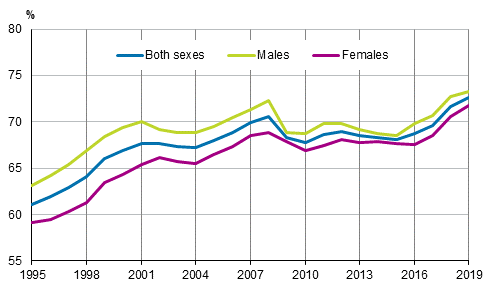
The employment rate of persons aged 15 to 74 was 62.2 per cent and among persons aged 20 to 64 it was 77.0 per cent in 2019. Employment rates with different age group divisions are available in the Labour Force Survey's database table Population by labour force status, sex, and age .
The employment rate rose in 2019 compared to the previous year in all age groups, most among those aged 55 to 64 and 25 to 34 (Figure 2). The employment rate was still highest (86.3%) in the 45 to 54 age group.
Figure 2. Employment rates by age group in 1995 to 2019, %
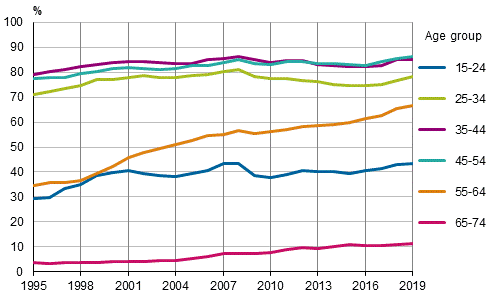
Growth in employment continued more subdued than in the previous year
In 2019, the number of employed persons aged 15 to 74 in Finland was 2,566,000, which is 26,000 higher than in the year before. The number of employed persons increased for the fourth year in succession (Figure 3). The number of employed persons increased in all quarters compared to the corresponding periods of the previous year, most in the first quarter.
Figure 3. Number of employed persons by sex in 1995 to 2019, persons aged 15 to 74
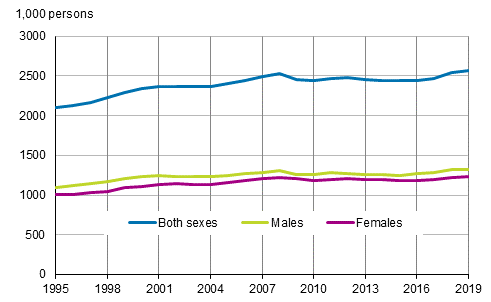
In 2019, the number of employed men aged 15 to 74 was 10,000 higher and that of women 16,000 higher than in 2018. Women's employment grew for the third year in a row, the growth in men's employment continued for the fourth year (Figure 4). However, growth in men’s employment almost halted in the third and fourth quarters compared to one year earlier.
Figure 4. Change from the previous year in the number of employed persons by sex in 2005 to 2019, persons aged 15 to 74
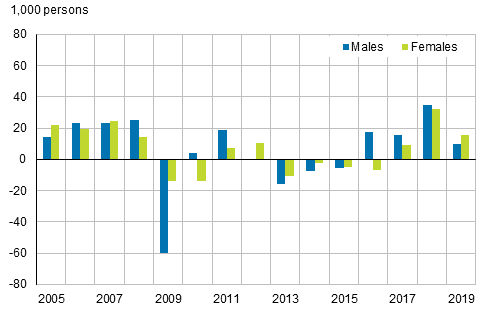
Number of employed persons increased most in accommodation and food service activities and decreased most in manufacturing industries
The number of employed persons increased in accommodation and food service activities (I) by 11,000 employed persons. Information and communication (J) continued to grow by 9,000 employed persons and business services (M, N) also by 9,000 employed persons, most of which came to administrative and support service activities (N). Growth also continued somewhat in the industry of education (P).
The number of employed persons increased from the previous year also in human health and social work activities (Q) by 5,000 persons and in the industry of agriculture, forestry, fishing and mining (A, B) by 4,000 persons. There was also some growth in the industry of arts, entertainment and recreation (R).
Compared with the previous year, the number of employed persons decreased in the industries of manufacturing (C) by 8,000 persons and in the industry of wholesale and retail trade (G) by 6,000 persons in total and in construction (F) by 5,000 employed persons. The number of employed persons decreased slightly in public administration and defence; compulsory social security (O). In transportation and storage (H) and in financial, insurance and real estate activities (K, L) the number of employed persons remained almost unchanged from the previous year.
Figure 5 shows the change from the previous year in the number of employed persons by industry in 2018 and 2019.
Figure 5. Change from the previous year in the number of employed persons by industry in 2018 and 2019, persons aged 15 to 74
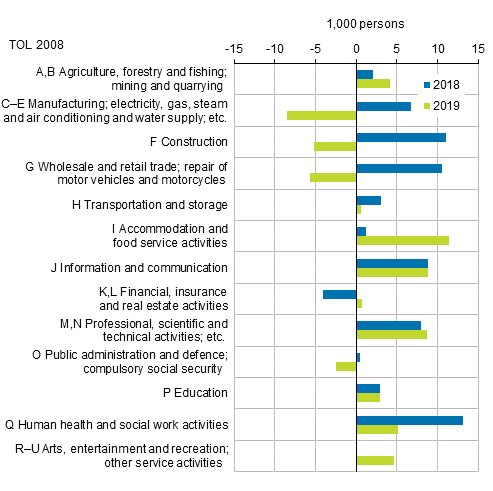
Number of upper-level employees and self-employed persons increased
The number of employed persons increased in the private sector by 31,000 in 2019. The number of women in the public sector fell slightly, while that of men was unchanged.
In 2019, the average number of employees was 2,220,000, which is 16,000 more than in the previous year. In 2019, the number of self-employed persons and unpaid family workers was 345,000, of which 10,000 were unpaid family workers. The number of self-employed persons and unpaid family workers grew by 10,000 persons. The share of employed persons remained at level of 2018 at 13 per cent.
In 2019, the number of self-employed persons was 335,000, which is 11,000 more than in 2018. Of them, self-employed employers numbered 97,000, which is 6,000 more than in the year before. One-third of all self-employed persons and one-quarter of self-employed employers were women. The number of self-employed without employees was 238,000, of whom 91,000 were women. There were 5,000 more female self-employed without employees compared to the previous year while the number of male self-employed without employees remained unchanged.
Examined by socio-economic group, the number of salaried employees, particularly of upper-level employees continued growing: in 2019 there were 32,000 more upper-level employees than in 2018. In lower-level employees the number of women fell by 28,000 persons and that of men grew by 13,000. The number of men in manual work occupations went down and that of women grew.
There were minor changes in the socio-economic structure of employees examined by gender. More than one-half of women, 51 per cent, worked as lower-level employees, while in the previous year, 54 per cent of women were working as lower-level employees. Of female employees, 30 per cent were upper-level employees, while the share was 28 per cent in the year before. The share of women working in manual worker occupations was 19 per cent. Of male employees, 42 per cent were in manual worker occupations, while the share was 44 per cent in 2018. The number of male employees working as salaried employees grew by 20,000 from 2018.
Number of hours worked unchanged
In 2019, hours worked in the national economy as a whole numbered 4.1 billion, nearly the same as in 2018. In 2019, the average number of hours actually worked per employed was 1,614 hours, whereas in 2018 the respective figure was 1,627 hours.
Number of underemployed almost unchanged
In 2019, the average number of underemployed persons was 138,000, or about the same as in 2018. Underemployed persons refer to persons who would like to do more work, but have to work part-time or a shortened working week or who do not have work due to a low number of orders, shortage of customers or due to being temporarily laid off. In all, 62 per cent of underemployed were women and 38 per cent were men.
2.2 Number of unemployed and persons in disguised unemployment decreased in 2019
The number of unemployed persons continued to fall. In 2019, the average number of unemployed persons was 184,000, whereas in 2018 they numbered 202,000. The number of unemployed men was 103,000 and that of women 82,000. The number of unemployed men decreased by 3,000 persons, and that of unemployed women by 15,000 persons.
The unemployment rate among persons aged 15 to 74 was, on average, 6.7 per cent in 2019, having been 7.4 per cent in 2018. The unemployment rate of men fell to 7.2 per cent and that of women to 6.2 per cent.
Besides unemployed persons, there were 114,000 persons aged 15 to 74 classified in the Labour Force Survey as being in disguised unemployment, who would and could have accepted work, but had not looked for it actively. The number of persons in disguised unemployment decreased by 14,000 compared with 2018 (Figure 6). More about persons in disguised unemployment in Section 4 Inactive population.
Figure 6. Unemployed persons and persons in disguised unemployment in 2005 to 2019, persons aged 15 to 74
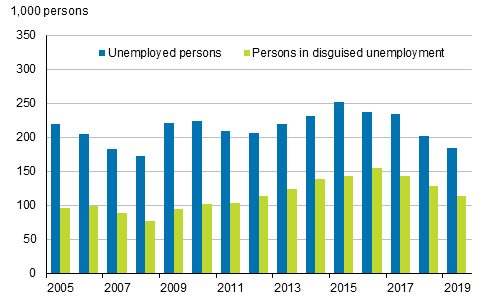
In 2019, the unemployment rate rose in the 15 to 24 age group, in the other ten-year age groups of persons aged under 65 the unemployment rates fell (Figure 7). The unemployment rate for people aged 15 to 24, that is, the share of the unemployed among the labour force, stood at 17.2 per cent, which is slightly more than one year previously. In all, 55,000 young people aged 15 to 24 were unemployed in 2019, which is 30 per cent of all unemployed persons. In the previous year, the number of unemployed persons in this age group was 54,000, which was 27 per cent of all unemployed persons.
The share of unemployed persons aged 15 to 24 in the population of the same age was 9.0 per cent in 2019 (Figure 8), having been 8.8 per cent in 2018.
Figure 7. Unemployment rates by age group in 1995 to 2019, %
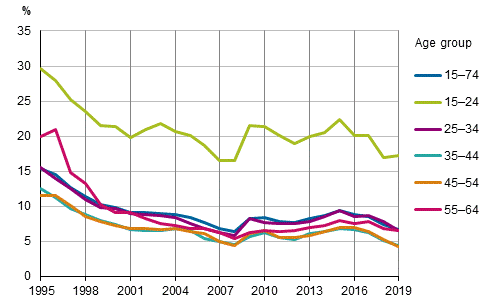
Figure 8. Shares of employed and unemployed persons, and inactive population of age group in 2019, %
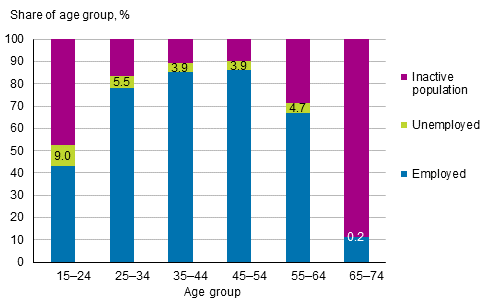
2.3 Growth in the labour force
In 2019, the working-age population or those aged 15 to 74 was 4,128,000, which is 4,000 more than in 2018. At the same time, the number of population aged 15 to 64 decreased by 11,000 persons. The number of population grew most in the 65 to 74 age group, in total by 14,000 from the previous year. The 55 to 64 age group decreased slightly from the previous year, but still remained the biggest of the examined ten-year age groups. (Figure 9.)
The number of persons aged 15 to 74 in the active population, i.e. the employed and unemployed, grew by 8,000 from 2018. The share of the active population of persons aged 15 to 74 was 66.6 per cent in 2019, the share stayed almost unchanged from the previous year.
In 2019, the number of persons aged 15 to 74 in the inactive population was 1,378,000, which is 4,000 fewer than in 2018. More about persons in the inactive population in Section 4 Inactive population.
Figure 9. Population of working age and active population by age group in 2019
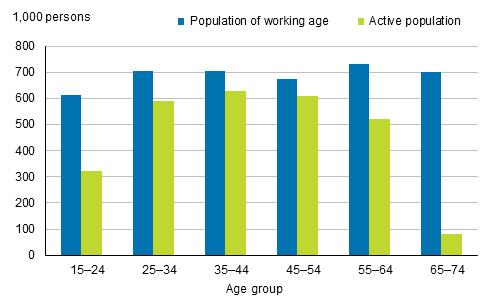
2.4 Two-thirds of temporary employees would had wanted a permanent job
Temporary employees’ share of all employees fallen slightly
In 2019, the average number of employees in Finland was 2,220,000, which is 16,000 higher than in 2018. In all, 350,000 employees had temporary employment contracts, 207,000 of whom were women and 143,000 men (Figure 10). The number of temporary employees went down by 13,000.
Figure 10. Number of temporary employees by sex in 2005 to 2019, persons aged 15 to 74
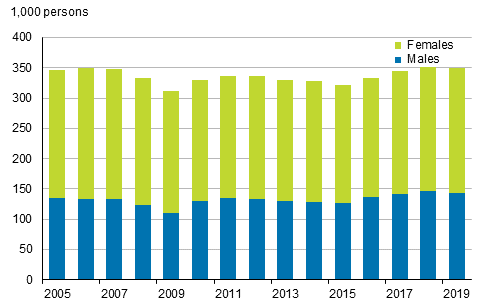
Eighty-four per cent of employees’ all employment contracts were permanent and 16 per cent temporary in 2019. Temporary employment relationships are more common for women than for men. Nineteen per cent of female employees and 13 per cent of male employees worked in a temporary employment relationship in 2019. (Figure 11.)
Figure 11. Share of temporary employees of all employees by sex in 2005 to 2019, persons aged 15 to 74, %
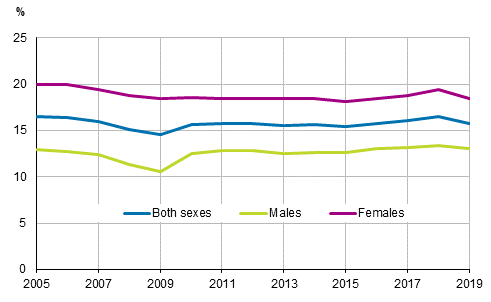
Persons aged 25 to 34 most in need of permanent work
In 2019, a total of 350,000 employees had a temporary employment relationship and 64 per cent of them or 222,000 said their reason for temporary work was lack of permanent work. Of them, 137,000 were women and 85,000 men. One-third of temporary employees who would have wanted a permanent job were aged 25 to 34. Of them, 45,000 were women and 28,000 men.
Lack of permanent work was also the most common reason for temporary work among temporary employees aged 35 to 44. Eighty per cent of persons of this age group named lack of permanent work as the reason for temporary work. Other, clearly less frequent reasons for temporary work than those mentioned above were practical training related to studies and probationary period.
Twenty-eight per cent of temporary employees did not want a permanent job. The majority of them were aged under 25, typically summer workers. However, 43 per cent of temporary employees (46,000) aged under 25 would have wanted a permanent job.
Nearly one-half of new employment contracts temporary, more often for women than men
In 2019, there were 503,000 employees whose employment relationship had lasted less than a year, which was nearly the same as in 2018. (Figure 12.)
Figure 12. Employees with employment contracts of under one year's duration in 2005 to 2019, persons aged 15 to 74
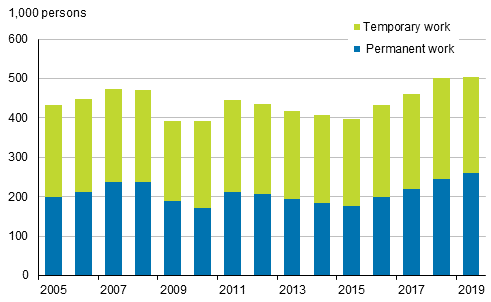
Forty-nine per cent of the employment contracts of under one year's duration were temporary, while the corresponding share was 51 per cent in 2018. The difference between men and women in the new employment relationship being temporary or continuous has narrowed down a little; 42 per cent of men’s and 54 per cent of women’s new employment relationships were temporary in 2019. In the previous year, 44 per cent of men’s and 57 per cent of women's new employment relationships were temporary.
Two per cent of employees did temporary agency work
Temporary agency work refers to an employment relationship in which an employee works via an enterprise which provides or hires out labour force. In 2019, the average number of temporary agency workers was 46,000, having been 43,000 in the previous year. Of them, 53 per cent were men and 47 per cent women.
Statistics on the number of temporary agency workers have been compiled in the Labour Force Survey since 2008. The number of temporary agency workers has grown from 2014 onwards somewhat every year. Starting from 2016, their share of employees has remained at two per cent.
Temporary agency workers are employed by several industries. The number of temporary agency workers was highest in wholesale and retail trade (G), manufacturing and electricity, gas, steam, air conditioning and water supply (C to E), construction (F), and accommodation and food service activities (I). Temporary agency work was most common in accommodation and food service activities, where the share of temporary agency workers in all employees was six per cent.
2.5 Number of part-time workers grew, shares of part-time workers remained nearly unchanged
More than one-fifth of female employees worked part-time, one-tenth of men
In 2019, altogether 439,000 employed persons worked part-time, which was 17 per cent of all employed persons. There were 16,000 more employed persons working part-time than in 2018. The number of employees working part-time was 356,000, which was 12,000 more than in the previous year. The Labour Force Survey data on part-time employment are based on the respondents’ own reporting. Next we examine only employees among those working part-time.
Part-time employment was more widespread among women than men. In 2019, twenty-two per cent of female employees worked part-time, or 244,000 persons and 10 per cent of male employees, 112,000. For both sexes the shares of persons working part-time of employees remained almost the same as in 2018. (Figures 13 and 14)
Working part-time is more common for younger employees and particularly for the oldest employees. Forty-three per cent of employees aged 15 to 24 worked part-time in 2019, primarily due to studies. In all, 67 per cent of employees aged 65 to 74 worked part-time.
Approximately three-quarters of part-time employees worked in the private sector. Part-time work was done most in the industries of human health and social work activities (Q), second most in wholesale and retail trade (G). The share of part-time workers in all employees in the industry was biggest in retail trade (excl. sale of motor vehicles), 44 per cent.
Figure 13. Part-time employees by sex in 2005 to 2019, persons aged 15 to 74
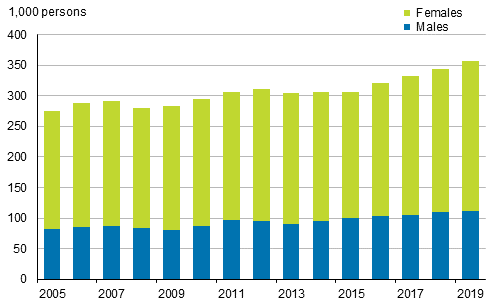
Figure 14. Share of part-time employees among employees by sex in 2005 to 2019, persons aged 15 to 74, %
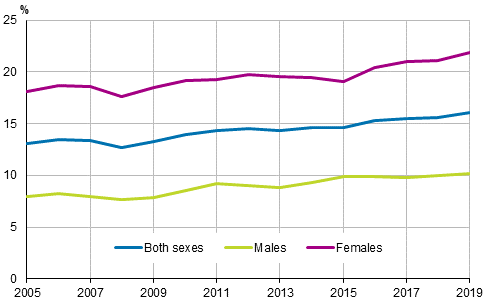
Nearly one-third of persons working part-time would like full-time work
Working part-time suits the life situation of many of those who are employed part-time. Of part-time workers underemployed are those who work part-time because full-time work is not available.
In 2019, there were 103,000 such part-time employees who would have wanted a full-time job. Of them, 71,000 were women and 32,000 were men. Lack of full-time work was the most common reason for working part-time for female employees. Nearly every third woman working part-time reported this reason. For men, the most common reason for part-time work was studying, which was reported by good one-third of part-time working men.
Other reported reasons for part-time work related to life situation were caring for children or relatives, and health reasons. Still nearly all of those who reported caring for children or relatives as the reason for working part-time were women. Nearly two-thirds of those aged 15 to 24 reported studying as the reason for part-time work.
2.6 Different forms of working among the employed
Full-time paid work is the most common form of working among persons aged 15 to 74. In 2019, altogether 63 per cent of all employed persons aged 15 to 74 were employees in full-time paid work based on an employment contract valid until further notice. The share has remained unchanged compared to the previous year. Figure 15 describes different forms and numbers of paid work grouped into most commonly monitored forms of working. (Figure 15.)
Figure 15. Different forms of working among employed persons aged 15 to 74 in 2019
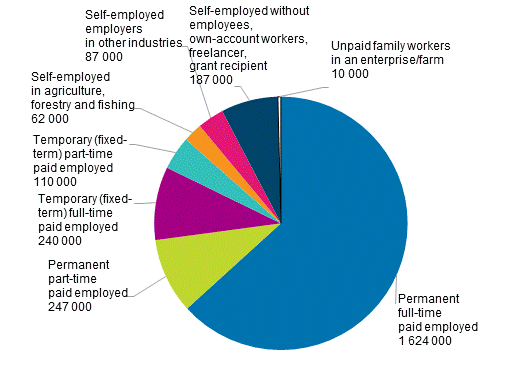
One-tenth of employed persons aged 15 to 74 were working in permanent part-time paid work, five per cent of men and 14 per cent of women. Nine per cent of employed persons were employees on a full-time temporary employment contract. Compared to the previous year, the number of employees in full-time temporary work has decreased by 13,000 persons. Four per cent of all employed persons were employees with a temporary part-time employment contract – three per cent of men and six per cent of women.
The share of persons working as self-employed without employees, own-account workers, freelancers and grant recipients (excl. agriculture, forestry and fishing) among all employed persons aged 15 to 74 was seven per cent in 2019. The number of self-employed persons grew slightly in all but the group of unpaid family workers. Changes in the shares between different forms of working are altogether fairly small.
Table 1. Different forms of working among persons aged 15 to 74 by sex in 2019, percentage share of all employed persons
| Males | Females | Both sexes | |
| Permanent full-time paid work | 67 | 59 | 63 |
| Permanent part-time paid work | 5 | 14 | 10 |
| Temporary full-time paid work | 8 | 11 | 9 |
| Temporary part-time paid work | 3 | 6 | 4 |
| Self-employed in agriculture, forestry and fishing | 4 | 1 | 2 |
| Self-employed employers (excl. self-employed in agriculture, forestry and fishing) | 5 | 2 | 3 |
| Self-employed without employees, own-account workers, freelancers, grant recipients (excl. self-employed in agriculture, forestry and fishing) | 8 | 6 | 7 |
| Unpaid family worker in an enterprise / farm | . | . | . |
Source: Labour Force Survey 2019. Statistics Finland
Inquiries: Ulla Hannula 029 551 2924, Tatu Leskinen 029 551 3285, tyovoimatutkimus@stat.fi
Director in charge: Jari Tarkoma
Updated 7.5.2020
Official Statistics of Finland (OSF):
Labour force survey [e-publication].
ISSN=1798-7857. Employment and unemployment 2019,
2 Employment and unemployment in 2019
. Helsinki: Statistics Finland [referred: 1.7.2024].
Access method: http://www.stat.fi/til/tyti/2019/13/tyti_2019_13_2020-05-07_kat_002_en.html

